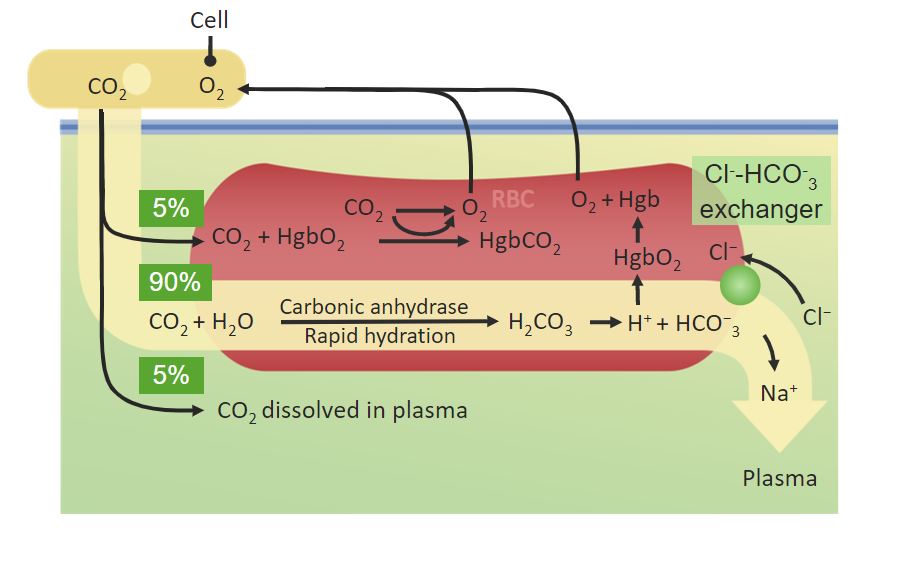Playlist
Show Playlist
Hide Playlist
Pulmonary Surface Tension – Breathing and Lung Mechanics
-
Slides 01 PulmonaryVentilation RespiratorySystem.pdf
-
Download Lecture Overview
00:01 Besides this notion of compliance, the other thing that we have to take into account is something known as surface tension. 00:10 Surface tension is an interesting physics principle in which a water molecule in air will form a droplet and it does because water adheres to each other and forms this surface tension around it. 00:30 So molecules at the surface of the drop adhere together and therefore create a drawing away from the center, which then cause there to be surface tension on the air to water interface. 00:48 This can also be seen in a place where water is simply around the surface of a particular object such as an air sac or alveoli. 01:01 There is water on the inside of that air space. 01:07 So the same thing will happen, the lining component will generate surface tension simply because there is an air to water interface. 01:19 Luckily, we have two types of pneumocytes. 01:23 The second, type II pneuomocyte, which is in a lower prevalence, only 5 to 10% of the alveolar space is covered by type II pneumocytes. 01:33 They produce a substance called surfactant. 01:39 A surfactant is a very important molecule. 01:42 It’s primarily a lipid, phospholipid, but has a little bit of protein in it as well. 01:48 But what’s very important about it is it has both a polar and non-polar side. 01:54 So what happens, if you think about this as having normal surface tension of an alveolus or you have water molecules, a surfactant molecule can be placed on this surface and what it does is reduce the amount of surface tension that two water molecules will produce when placed next to each other. 02:19 So the more amount of surfactant that’s on this barrier between the air and water, the lower the surface tension. 02:29 So why is this important in pulmonary and respiratory medicine? And that is because there is a law known as the law of LaPlace in which you will have -- Certain sized air sacs will have a different amount of surface tension. 02:47 So here, we have two air sacs. 02:50 The larger the air sac, the easier it is for it to inflate. 02:56 The smaller the air sac, the more surface tension that it has. 03:01 What surfactant does is reduces the need to have different-sized air sacs. 03:07 So if pressure comes into an alveoli, with surfactant present, it will inflate it no matter if it’s small in size or larger in size. 03:19 So surfactant allows us to take out this principle of surface tension because a surfactant molecule helps reduce it. 03:28 However, there are some clinical conditions such as a premature infant being born, who may not have produced enough surfactant yet. 03:37 And in that case, they’re going to operate under this principle of having too much surface tension. 03:45 And if you were mechanically ventilating a patient such as this, you have the propensity to overinflate certain air sacs that have reduced surface tension such as those large alveoli.
About the Lecture
The lecture Pulmonary Surface Tension – Breathing and Lung Mechanics by Thad Wilson, PhD is from the course Respiratory Physiology.
Included Quiz Questions
Which of the following pneumocytes are immature in premature infants causing trouble with alveolar ventilation?
- Type II
- Type I
- Type III
- Type IV
- Type V
Which of the following statements is NOT true regarding the surfactant?
- It has only non polar sides.
- It is produced by type II pneumocytes.
- It is a mixture of lipids and proteins.
- It has polar and non polar sides.
- It reduces surface tension.
Customer reviews
4,5 of 5 stars
| 5 Stars |
|
1 |
| 4 Stars |
|
1 |
| 3 Stars |
|
0 |
| 2 Stars |
|
0 |
| 1 Star |
|
0 |
Me parece una buena clase, con una muy buena explicación, pero faltaron algunos detalles, por ejemplo: explicar la manera en la que el surfactante reduce la tensión superficial y su composición exacta.
I have paid for the lecturio.de physiology course but did not understand much because it is so badly explained. Here Dr Wilson explains so well, I understood things I was not expecting to understand any time soon. So 5 stars because the concepts well explained; clear slow speech, physical laws explained, and contrasted with diseases. I would love to hear more lessons from you.






